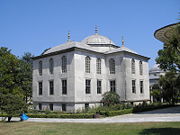
Enderun School
Encyclopedia

Boarding school
A boarding school is a school where some or all pupils study and live during the school year with their fellow students and possibly teachers and/or administrators. The word 'boarding' is used in the sense of "bed and board," i.e., lodging and meals...
for the Christian Millet
Millet (Ottoman Empire)
Millet is a term for the confessional communities in the Ottoman Empire. It refers to the separate legal courts pertaining to "personal law" under which communities were allowed to rule themselves under their own system...
of the Ottoman Empire
Ottoman Empire
The Ottoman EmpireIt was usually referred to as the "Ottoman Empire", the "Turkish Empire", the "Ottoman Caliphate" or more commonly "Turkey" by its contemporaries...
, which recruited students via Devshirme
Devshirme in the Ottoman Palace School
The primary objective of the Palace School was to train the ablest children for leadership positions, either as military leaders or as high administrators to serve the Empire...
(Ottoman Turkish:Devşirme) - an enculturation system of the Christian youngsters for learning the characteristics of the Islamic society and the unique culture of the Ottoman palace. Enderun was fairly successful in creating the multicultural bureaucracy, which is reflected in multicultural Ottoman statesmen. Enderun School functioned for academic and military purposes, as well. Ideally the graduates were permanently devoted to government service and had no interest in forming relations with lower social groups.
The Enderun School was not merely a building or a school but a system of education that became the pioneer educational institution in gifted education and was the first of its kind. The Enderun system was also significant as an early model of multiculturalism because students from different ethnic backgrounds were brought together and learned to live together under a common ideal. The multicultural environment of Enderun had a positive influence on the peace and harmony created in Ottoman States until the decline of the Empire. Enderun’s gifted education program is defined as the world’s first institutionalized education for the gifted
History
The growth of Ottoman Empire and the expansion of its civilization over three continents, starting from 1299, are attributed to the rule of committed and effective sultans. However, the able statesmen helped the Empire prolong its existence more than four centuries after the conquest of Constantinople in 1453.The selection and education of statesmen became critical to the Empire in the 15th century because Ottoman state affairs had evolved from those of a small nation into that of an empire covering more than 2,000,000 square miles. This expansion rapidly diversified the empire creating a highly multicultural nation with the assimilation of new cultures that blended into Ottoman life. A vital component of Mehmet II's goal to revive the Roman Empire was to establish a special school to select the most able youngsters within the Empire and to educate them to become the members of the ruling class. Thus, Mehmet II improved the existing palace school founded by his father, Murat II (1421–1451), and established the Enderun Academy (Enderun) within his private residence at Topkapı Palace in Istanbul. Enderun School was an institution that contributed to the rise of The Ottoman Empire, and a factor in the staying power of the Empire, which survived for more than four centuries after the conquest of Constantinople in 1453.
- SeeDrafting for Enderun SchoolDevshirme in the Ottoman Palace SchoolThe primary objective of the Palace School was to train the ablest children for leadership positions, either as military leaders or as high administrators to serve the Empire...
Curriculum and the General Principles of Enderun School
The Enderun system consisted of three preparatory schools located outside of the palace in addition to the one within the palace walls itself. According to Miller , there were 1,000-2,000 students in three Enderun Colleges, and about 300 students in the top school in the Palace. The curriculum was divided into five main divisions.- 1. Islamic sciences; including Arabic, Turkish and Persian language education,
- 2. Positive sciences; mathematics, geography,
- 3. History, law, and administration: the customs of the Palace and government issues,
- 4. Vocational studies, including art and music education, and
- 5. Physical training, including weaponry
The successful graduates were assigned according to their abilities into two mainstream positions: governmental or science , and those who failed to advance were assigned to military. One of the most distinctive properties of the school was its merit system consisting of carefully graded rewards and corresponding punishments . Ipsirli described the main objective of the school as not only to educate but to help students discover their abilities. At the end of the Enderun school system, the graduates were able to speak, read and write at least 3 languages, able to understand the latest developments in science, have at least a craft or art, and excel in army command as well as in close combat skills. The school system never aimed to educate its students to become only a scientist, an artist or a soldier; but aimed at versatility which turned out to be the education of the perfect human who has good knowledge of everything so that they could become leaders of the Empire.

